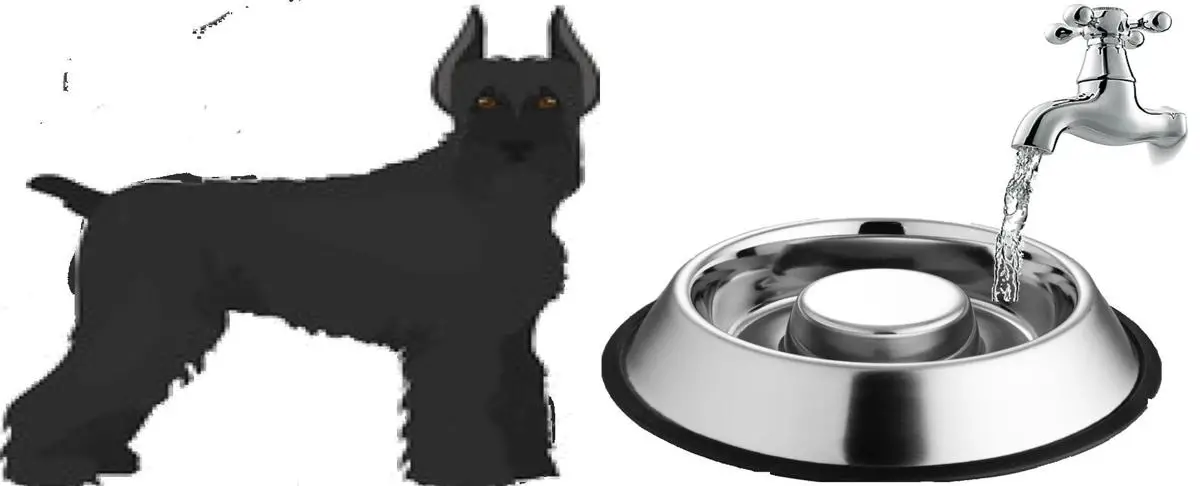Quick Links: Table of Contents
- Giant Schnauzer Breed Overview
- History of the Giant Schnauzer Breed. Where Giant Schnauzers came from
- What the Giant Schnauzer Looks Like
- How Much is the Giant Schnauzer Puppy?
- Best Giant Schnauzer Breeders
- Adopting or Rescuing the Giant Schnauzer
- Giant Schnauzer Growth
- What Colors do Giant Schnauzers Have?
- The Temperament of the Giant Schnauzer
- Giant Schnauzer Litter Size
- How Fast Giant Schnauzers Can Run
- Good Names for Giant Schnauzers
- How Intelligent are Giant Schnauzers?
- How Popular are Giant Schnauzers with New Dog Owners?
- Health Problems in Giant Schnauzers and How to Prevent Them
- How to Take Care of Giant Schnauzer
- Dog Breeds That Are Similar to Giant Schnauzers
- Other Things to Know About Giant Schnauzers
Giant Schnauzer Breed Overview
The Giant Schnauzer is a large-sized dog.
The adult Giant Schnauzer stands 23 to 27 inches tall at the shoulder.
The Giant Schnauzer belongs to the Working Dogs group.
Dogs in the Working Dogs group, like the Giant Schnauzer, were developed to assist humans in some capacity – including pulling sleds and carts, guarding flocks, guarding homes, and protecting their families.
Breeds in the Working Group are known for their imposing stature, strength, intelligence, and fearless.
Because of their size and strength, working dogs require a structured home life and firm, fair, consistent training by someone who can provide leadership without resorting to anger or physical force.
The fact that the Giant Schnauzer belongs to the Working Dogs group is one of the reasons why Giant Schnauzers have the personality and temperament that they have.
The temperament of the Giant Schnauzer is generally described as:
- Dominant
- Intelligent
- Kind
- Loyal
- Powerful
- Strong Willed
History of the Giant Schnauzer Breed. Where Giant Schnauzers came from
There are three types of Schnauzers.
The Standard Schnauzer is the original breed, and the Miniature Schnauzer and Giant Schnauzer are descended from it.
The Giant Schnauzer`s exact date of birth is unknown.
The Standard Schnauzer has been depicted in artwork dating back to 1492, and the Giant Schnauzer was developed sometime after that.
He was designed to be a herder and livestock guardian.
The Standard Schnauzer was crossed with larger dogs such as the Great Dane and the Bouvier des Flandres to create the Giant Schnauzer.
Initially, the Giant Schnauzer was bred to drive cattle to market.
He was no longer used for that purpose by the turn of the twentieth century.
He was later discovered patrolling breweries, stockyards, and butcher shops.
The Giant Schnauzer has been trained for police work in the United States and Europe.
Due to their size and proclivity for aggression, Giant Schnauzers are no longer commonly used for police work if not properly trained.
The American Kennel Club first recognized the Giant Schnauzer in the United States in 1930, and it is now ranked 94th in popularity among all dog breeds.
He is a high-maintenance dog who requires professional grooming.
He is also a high-energy dog who needs training and lots of exercise.
The Giant Schnauzer is not suitable for first-time dog owners and is not suitable for children.
.
What the Giant Schnauzer Looks Like
The top coat of the Giant Schnauzer is dense and wiry, with a soft undercoat.
its hair on top of its head is coarse, and its beard and brows are also wiry and coarse.
its beard and brows are a Schnauzer`s signature look, which can also be seen in Standard and Miniature varieties.
The Giant Schnauzer comes in solid black or pepper and salt.
When the topcoat is pepper and salt, it combines banded hairs that are white with black, black with white, and some black and white hairs.
When viewed from a distance, This appears gray.
Only a small white spot on its chest is permitted.
All pepper and salt shades, from silver-gray to dark iron gray, are acceptable.
.
How Much is the Giant Schnauzer Puppy?
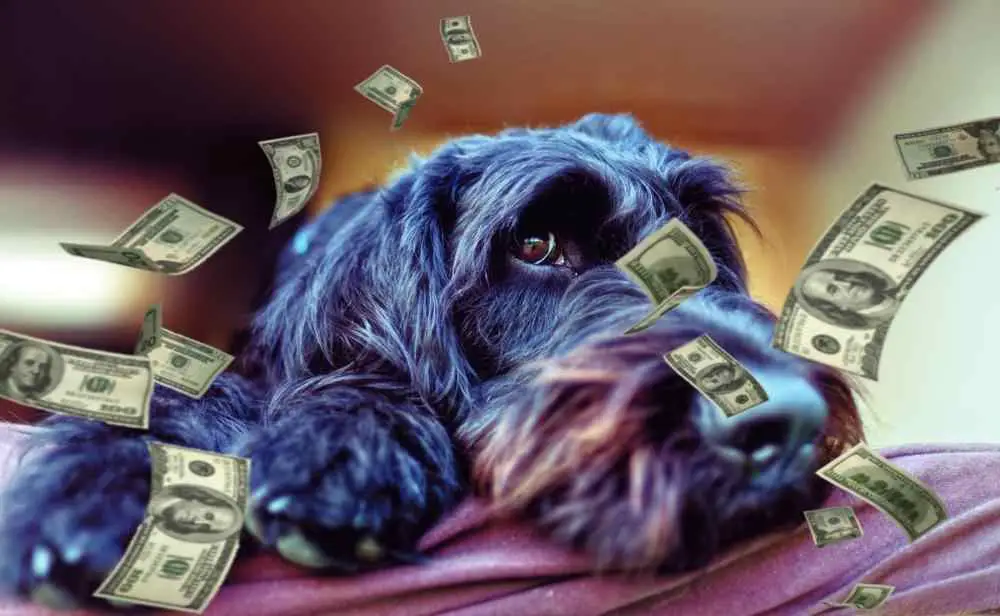
The average price of a Giant Schnauzer puppy is $2280. The price of a Giant Schnauzer puppy ranges from $2000 to $2500.
A lot of factors determine the price of the Giant Schnauzer. These factors include what health records the Giant Schnauzer puppy has, the lineage of the Giant Schnauzer puppy, the US state the breeder is located in, etc.
To estimate how much you can expect to pay for a puppy Giant Schnauzer based on the many factors that determine the price of the Giant Schnauzer puppy, check out our calculator that lets you estimate how much you should expect to pay for the Giant Schnauzer puppy based on what you want in the puppy.
When looking to buy a puppy, look at buying a puppy only from well-established breeders that breed puppies primarily for the love of the Giant Schnauzer breed, and secondarily for profit. Do not buy a puppy from a puppy mill. Puppy mills mass-produce puppies in bad living conditions for maximum profit.
You may also consider adopting instead of buying a puppy. Adoption costs are very low compared to the price of a puppy.
Best Giant Schnauzer Breeders
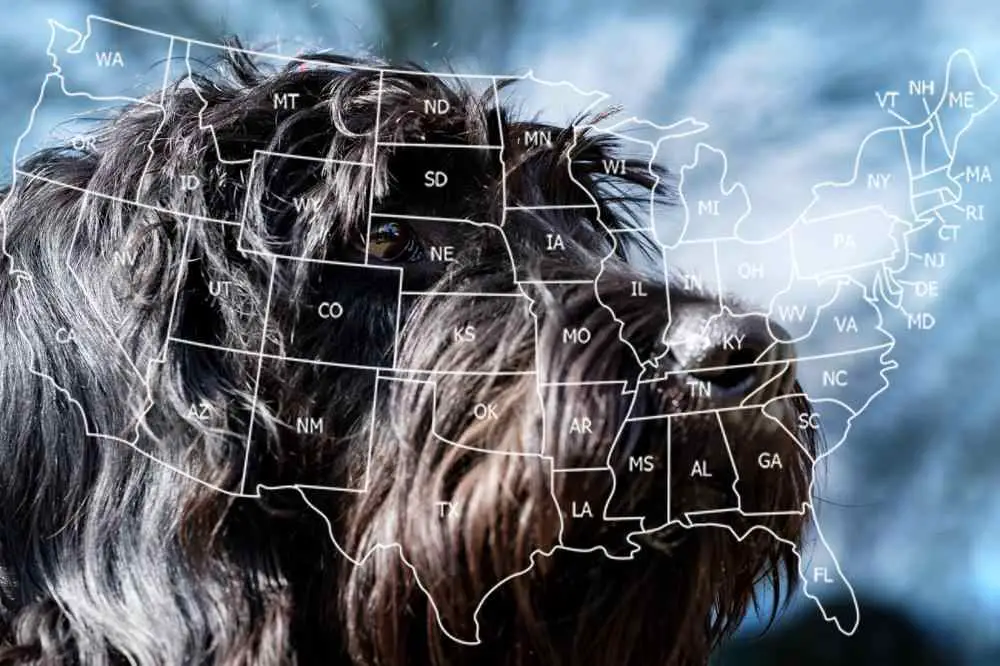
We have researched reputable Giant Schnauzer breeders that you can buy a puppy.
Go to this page for our complete list of reputable Giant Schnauzer breeders in various states in the United States.
On this page, you will see how much these breeders sell their puppies for, and how many puppies they have available.
A few of these breeders are listed below.
Puppies are Here!!!!
Puppy Price: $2000
Garnavieve Beeson
Puppy Price: Check with breeder
Obsidian Giant Schnauzers
Puppy Price: Check with breeder
Paisleys Palace
Puppy Price: Check with breeder
Ilybeth Colon
Puppy Price: $2,200
Adopting or Rescuing the Giant Schnauzer
You may consider adopting a dog instead of buying a puppy. Many dogs, Giant Schnauzers included, are currently available for adoption in your local dog shelters.
These helpless but adorable dogs are waiting in dog shelters hoping that someday someone will rescue them. Dog adoption costs are lesser than the cost of a new puppy. Dog adoption costs are usually around $300 or even less.
In addition to your local dog shelter, another good place to find dogs that are available for adoption is petfinder.com.
Below is an adorable Male Giant Schnauzer named Loki that is currently available for adoption on Petfinder.com. You can find other lovely Giant Schnauzers like Loki on pefinder.com.
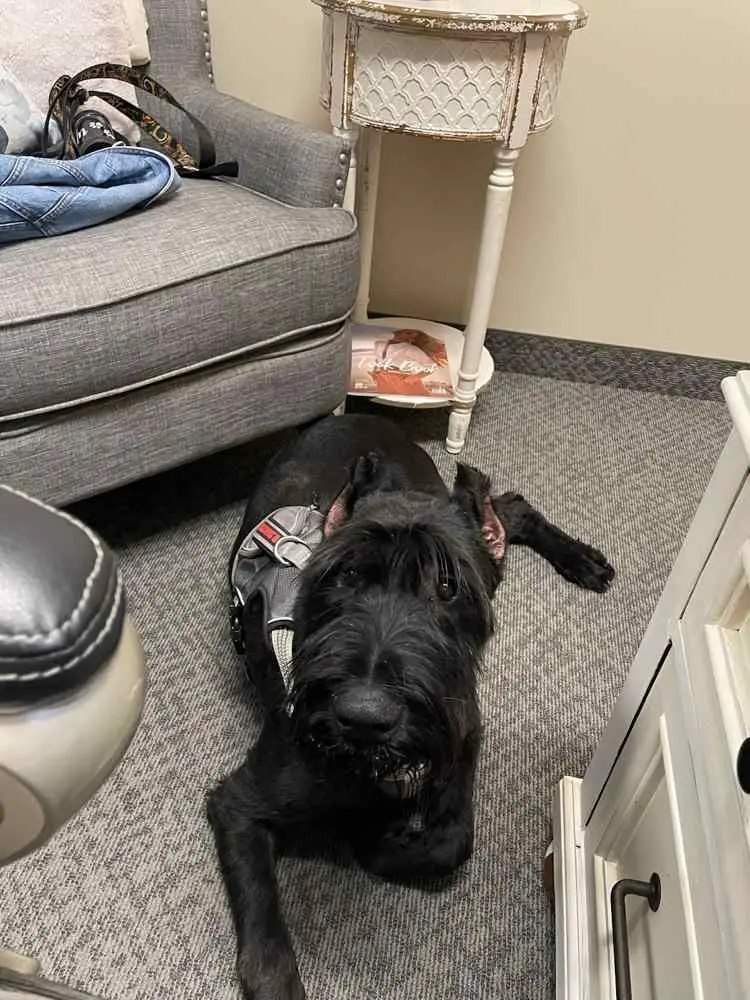
Bishop is the name of another Giant Schnauzer (Male) on petfinder.com that is looking for a new forever home.

You can find more Giant Schnauzers that are available for adoption on petfinder.
Giant Schnauzer Growth

New Giant Schnauzer owners need to know about the growth of their Giant Schnauzers. This will help them plan their living spaces accordingly.
Also, knowing the typical growth pattern of the Giant Schnauzer will help new owners catch the abnormal growth of their Giant Schnauzer early.
See our calculator for predicting how big your Giant Schnauzer puppy will get. You will also learn about the typical weight of the Giant Schnauzer at different ages and how to catch abnormal growth in your Giant Schnauzer
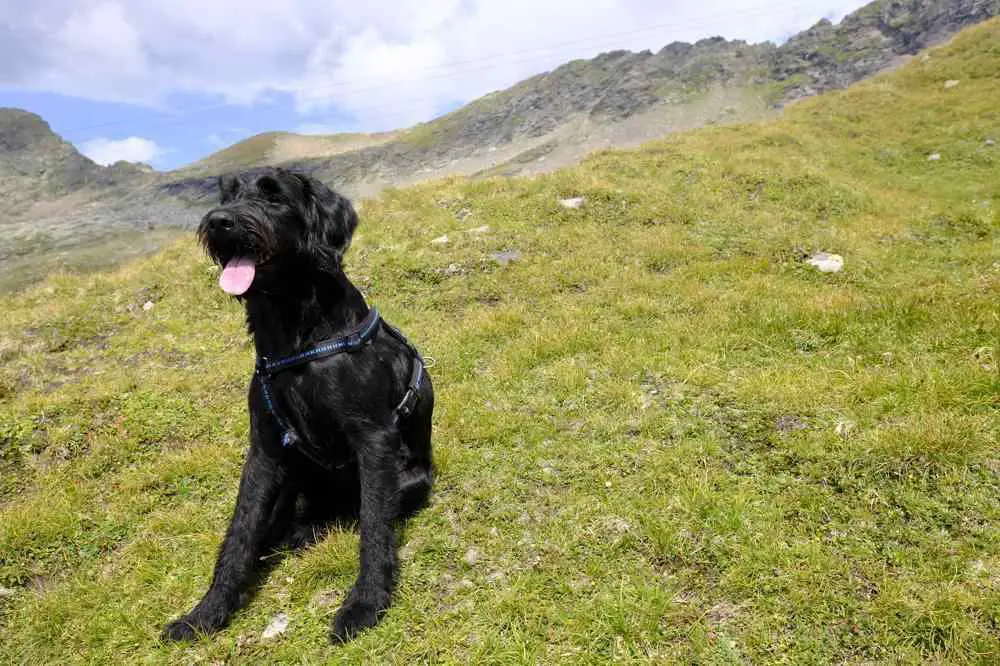
What Colors do Giant Schnauzers Have?
Giant Schnauzers come in the following beautiful primary colors:
- Black
- Brown / Chocolate
- Gray / Blue / Silver
- Tricolor (Brown, Black, & White)
Giant Schnauzers come in the following lovely secondary colors in addition to their primary colors:
- Gray / Blue / Silver
- White / Cream

The Temperament of the Giant Schnauzer
The temperament of the Giant Schnauzer based can be summarized as in the table below.
The table shows the scores of the Giant Schnauzer for 13 important dog behavioral factors.
We obtained these scores by analyzing raw data from the C-BARQ dog personality survey tool. The higher the score of a dog for a factor, the worse the temperament of the dog regarding that factor.
The C-BARQ tool was developed by researchers from the University of Pennsylvania, and it is a scientific tool that is used worldwide for reliably measuring the temperament of dog breeds.
See our complete analysis of the temperament of the Giant Schnauzer here.
| Factor | Score |
|---|---|
| Separation Related Behavior | 8.2 percent |
| Energy Level | 74.3 percent |
| Attachment Attention Seeking | 69.6 percent |
| Prey Drive | 62.4 percent |
| Excitability | 50.6 percent |
| Stranger Directed Fear | 5.7 percent |
| Dog Rivalry | 47.2 percent |
| Dog Directed Aggression | 45.8 percent |
| Stranger Directed Aggression | 42.3 percent |
| Touch Sensitivity | 20.2 percent |
| Stubbornness | 19.9 percent |
| Owner Directed Aggression | 10.3 percent |
| Dog Directed Fear | 0.0 percent |
| Nonsocial Fear | 0.0 percent |
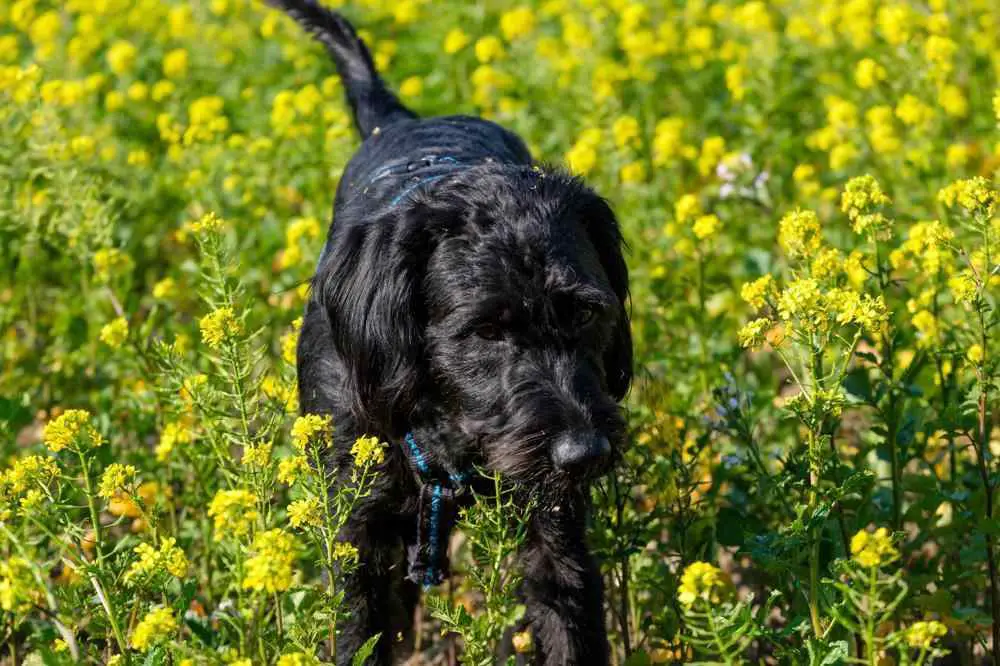
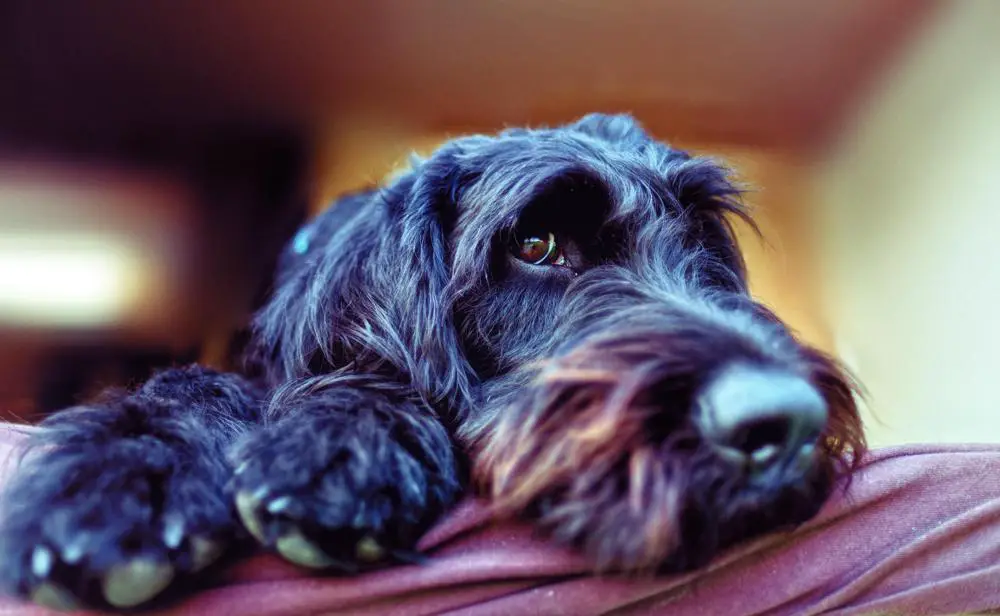
Giant Schnauzer Litter Size
Researchers from the Norwegian School of Veterinary Science did a study where they counted the numbers of puppies in 42 different Giant Schnauzer birth litters.
From this study, the researchers found that the average number of puppies that Giant Schnauzers can have is 7 puppies. Also, the Giant Schnauzer can have as few as 1 puppies per litter and as many as 14 puppies per litter.
The number of puppies that the Giant Schnauzer will have depends on factors such as the age of the Giant Schnauzer, the method of pregnancy, etc.
Click here to see our calculator for predicting how many puppies your Giant Schnauzer will have and how the litter size of the Giant Schnauzer compares to the litter size of other dog breeds.
How Fast Giant Schnauzers Can Run
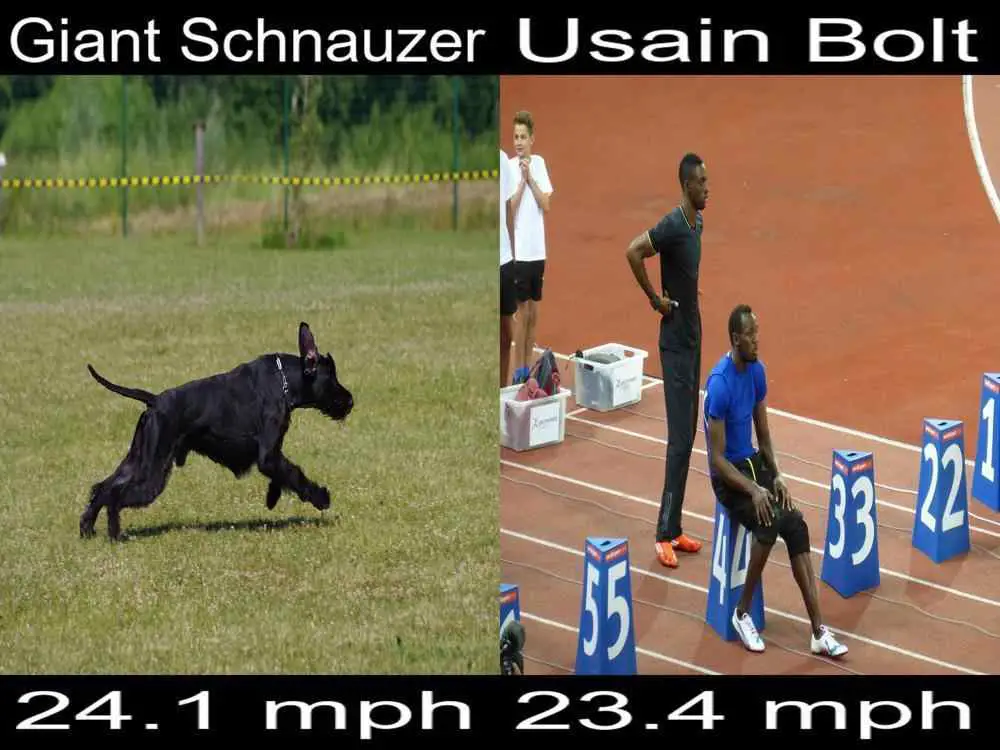
How fast a dog breed can run is a good measure of how athletic the dog breed is.
The American Kennel Club (AKC) regularly conducts dog running competitions. The AKC records the running speed of competing dogs in these competitions. These competitions are open to all dog breeds.
Based on our analysis of the speeds of 88 different Giant Schnauzers, the average speed of the Giant Schnauzer is 24.1 mph (38.8 kmph).
The fastest speed on AKC record that the Giant Schnauzer ran in a race is 29.67 mph (47.7 kmph) and the minimum speed on record in a race for a Giant Schnauzer is 8.07 mph (13.0 kmph).
Click here to see how the speed of the Giant Schnauzer compares to the speed of other dogs and other mammals such as cats, horses, humans, etc.

Good Names for Giant Schnauzers
Here are some really good names that are typical for the Giant Schnauzer ranked by popularity:
- Hendrix
- Murphy
- Davy
- Bishop
- Milo
- Tramp
- Loki
- Simba
- Dweezle
- Hendrix
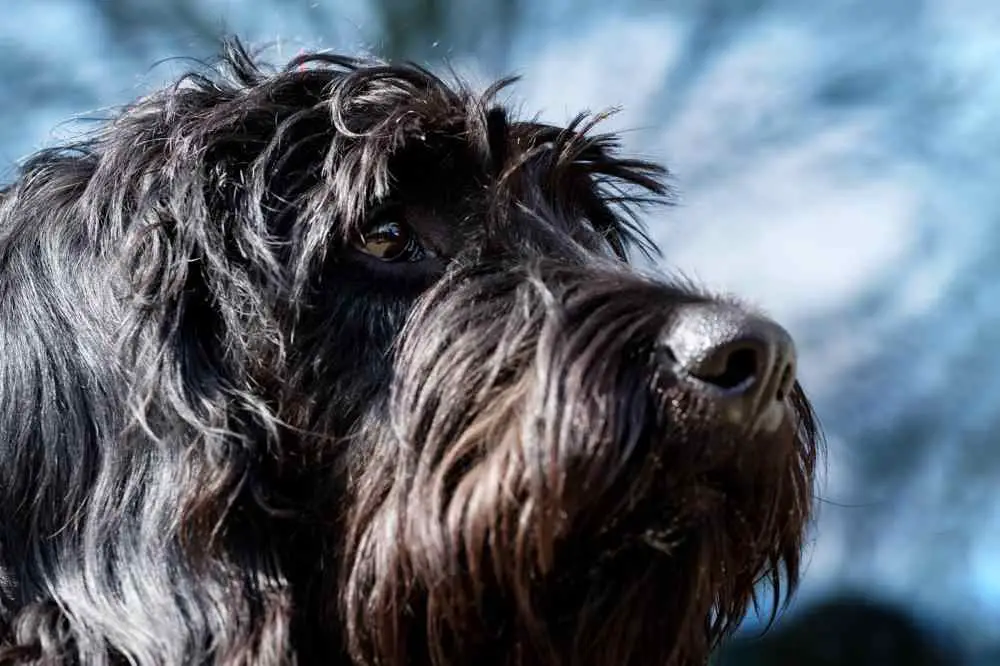
How Intelligent are Giant Schnauzers?
| Giant Schnauzer | |
|---|---|
| Intelligence Rank | 28 out of 130 dog breeds |
| Trainability | Tend To Learn New Commands After 15 To 25 Repetitions |
According to Prof. Stanley Coren, a Canadian psychology professor/dog trainer, the total intelligence that a dog demonstrates is the addition of three types of intelligence. These intelligence types are:
- Instinctive Intelligence: This is the natural intelligence that comes from instinct. For example, dog breeds that have been historically bred to be guard dogs will have a high `guarding` intelligence compared to dogs that were not bred for guarding.
- Adaptive Intelligence (learning and problem-solving ability): This indicates what a dog can learn to do for himself or herself. Adaptive intelligence is specific to each dog, and not breed specific. You can improve your dog`s adaptive intelligence by investing time to train your dog.
- Working/Obedience Intelligence: This type of intelligence is breed-specific. Certain dog breeds tend to have higher working/obedience intelligence than some other breeds. This intelligence is the closest to what we might call school-learning ability and it is based upon what the dog can learn to do when instructed by humans. This type of intelligence can be measured for each dog breed and compared to that of other dog breeds.
Professor Stanley Coren measured and ranked the working intelligence of about 130 different dog breeds.
Prof. Coren found that the Giant Schnauzer has an obedience intelligence rank of 28 out of 130 dog breeds. Thus, Prof. Coren put Giant Schnauzers in the `Above Average Working Dogs` category.
This means that Giant Schnauzers tend to learn new commands after 15 to 25 repetitions.
However, we should mention that a dog should not be judged based on its intelligence alone. There are other important factors you need to consider when deciding on which dog breed to get. These other factors include sociability, adorability, and compatibility of the dog breed with your lifestyle.
See the intelligence ranking of some other dog breeds below:
| Breed | Intelligence Rank |
|---|---|
| Border Collie | 1 |
| Standard Poodle | 2 |
| Doberman Pinscher | 5 |
| Rottweiler | 9 |
| Pembroke Welsh Corgi | 11 |
| Miniature Schnauzer | 12 |
| German Shorthaired Pointer | 17 |
| Cardigan Welsh Corgi | 26 |
| Chesapeake Bay Retriever | 27 |
| Giant Schnauzer | 28 |
| Affenpinscher | 37 |
| Norwich Terrier | 38 |
| Bichon Frise | 45 |
| Scottish Deerhound | 47 |
| Alaskan Malamute | 50 |
| Italian Greyhound | 60 |
| Chinese Crested | 61 |
| Lhasa Apso | 68 |
| Bloodhound | 74 |
| Chow Chow | 76 |
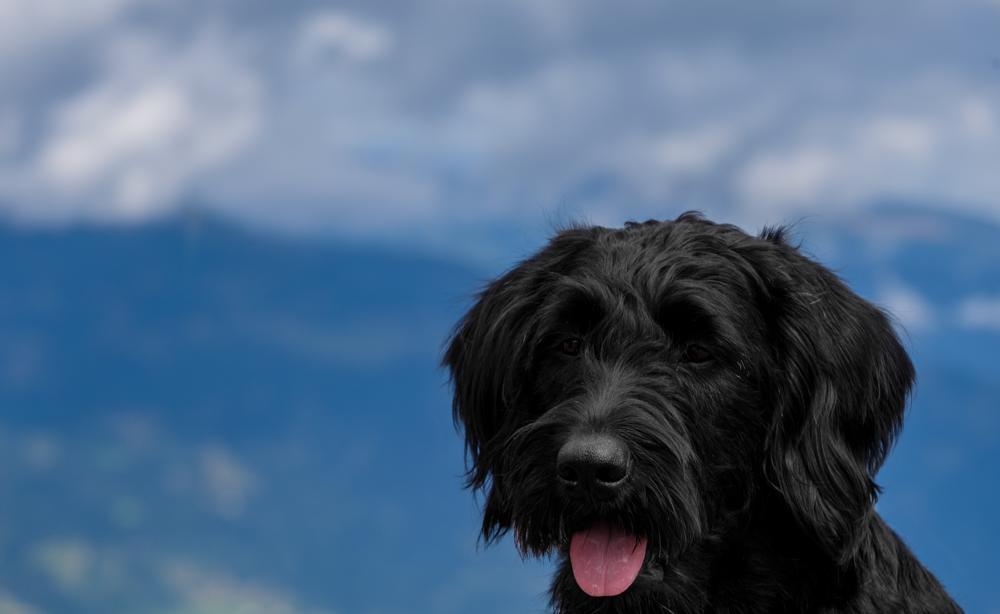
How Popular are Giant Schnauzers with New Dog Owners?
Every year, the American Kennel Club (AKC) publishes information on how popular a dog breed is in that particular year. The AKC gets the popularity information of a breed from how many dogs of that breed the owners register with the AKC every year. The AKC collects this data for about 200 dog breeds.
The graph below shows the popularity trend of the Giant Schnauzer.
The popularity of the Giant Schnauzer averaged over the years is Number 76 out of about 200 dog breeds.
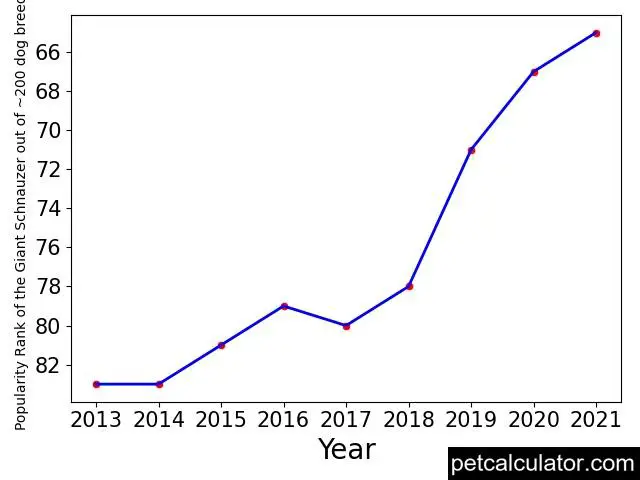
Do not get a dog breed just because it is a popular dog breed. And do not reject a dog breed just because it is an unpopular breed.

Health Problems in Giant Schnauzers and How to Prevent Them
Every dog breed has its own set of health problems that it tends to develop. There is nothing like a perfect dog breed.
The Giant Schnauzer is prone to certain genetic health conditions. The Orthopedic Foundation for Animals (OFA) is an organization that keeps track of genetic health problems in dog breeds.
From the extensive records that the OFA keeps, the OFA knows what health problems each dog breed is naturally prone to develop.
Hence, the OFA recommends which health screening breeders should perform on a dog breed to make sure that the breeders won`t breed `defective` dog parents that can pass down defective genes to their puppy offspring.
If you want a Giant Schnauzer puppy that will grow up to be healthy, make sure that your Giant Schnauzer breeder screens your puppy or your puppy`s parents for the health problems that the OFA recommends for your puppy`s breed. This will increase the chances that your puppy is free from genetic defects.
The following are the health tests that Orthopedic Foundation for Animals (OFA) recommends that breeders should screen Giant Schnauzers for:
You can find out more about OFA`s recommended tests for Giant Schnauzers here.
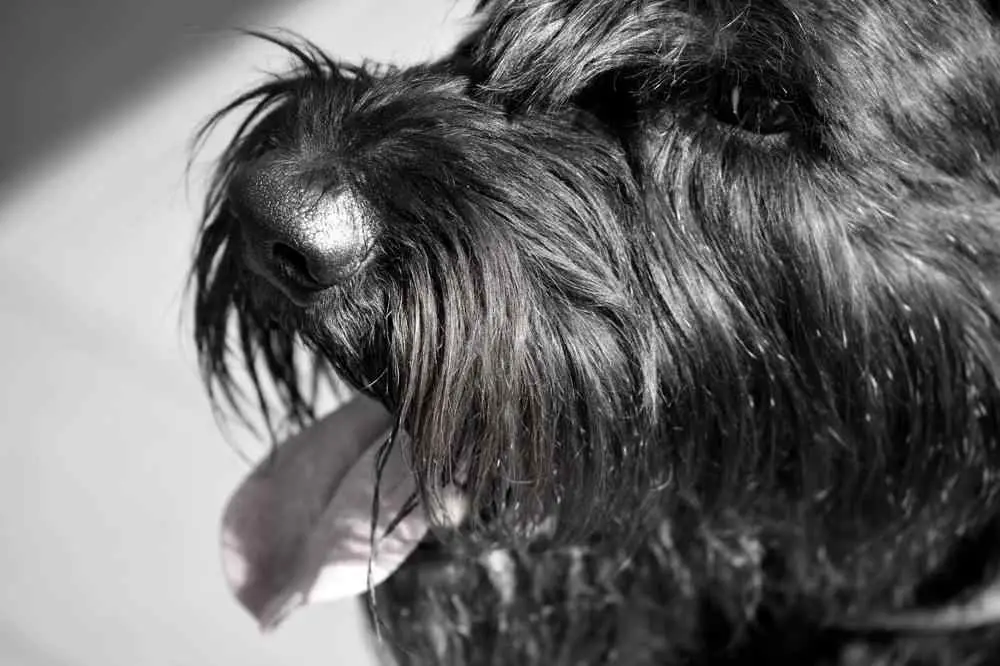
How to Take Care of Giant Schnauzer
To take good care of your Giant Schnauzer, you need to make sure that you groom your Giant Schnauzer regularly.
Secondly, you need to find a veterinarian in your area that will routinely check the health status of your Giant Schnauzer regularly, and give you appropriate recommendations on your Giant Schnauzer`s preventative care.
Thirdly, you need to commit some time to exercise your Giant Schnauzer daily. Regular exercise helps improve the health and quality of life of your Giant Schnauzer.
Also, you need to feed your Giant Schnauzer high-quality dog food, and the food should be of the right amount to prevent your Giant Schnauzer from getting overweight or underweight.
See our recommendations on what to feed the Giant Schnauzer and how much food to feed the Giant Schnauzer at different life stages.
Finally, you need to make sure that your Giant Schnauzer has access to clean water all the time. See our recommendations on how much water your Giant Schnauzer needs to drink at different ages.
Dog Breeds That Are Similar to Giant Schnauzers
If you have not made up your mind on which dog breed to get, you may also want to consider some other dogs similar to the Giant Schnauzer.
We crunched the numbers and found that the following dog breeds that have similar behavior and temperament as the Giant Schnauzer:
- Airedale Terrier (76 percent match with Giant Schnauzer). Learn more about the Airedale Terrier here.
- Alaskan Klee Kai (75 percent match with Giant Schnauzer). Learn more about the Alaskan Klee Kai here.
- Belgian Tervuren (75 percent match with Giant Schnauzer). Learn more about the Belgian Tervuren here.
- Gordon Setter (79 percent match with Giant Schnauzer). Learn more about the Gordon Setter here.

Other Things to Know About Giant Schnauzers
Here are some of the very important characteristics of the Giant Schnauzer that you need to know about the Giant Schnauzer breed:


